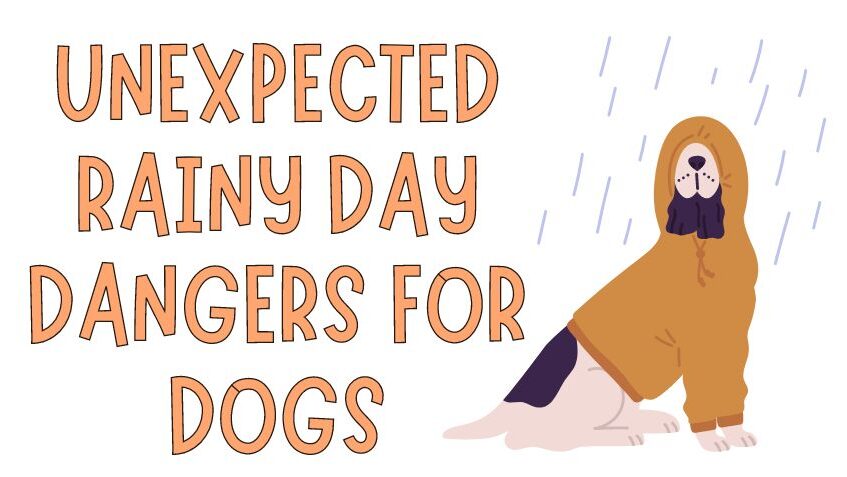Unexpected Rainy Day Dangers for Dogs
Rainy days can certainly dampen the spirits of both humans and our furry companions, dogs. Rainy weather not only means wet walks, reduced exercise, and limited outdoor playtime for them but also brings along unforeseen dangers and problems.
To keep your dog safe on rainy days, it’s essential to plan ahead and take necessary precautions. Provide them with a safe and dry environment, avoid hazardous areas, and ensure they stay warm and dry during outdoor activities.
Low Visibility, Lightning, and Thunder

Rainstorms often bring fog, downpours, thunder, and lightning—all of which lead to decreased visibility and sudden, unexpected noise. Loud claps of thunder can spook many pooches, causing them to react and run away. This can lead to missing dogs and accidents, because cars have difficulty seeing through the inclement weather. It can be a deadly combination.
Thunder can cause dogs a great deal of anxiety. This stress can cause pets to hurt themselves as they try to chew or scratch their way into or out of rooms and crates (a common thunder phobia response). It’s important to discuss possible storm phobias with your primary care veterinarian, as there are many great options (both holistic and medication) to help calm dogs in storms.
Lightning strikes are also possible, though rare, and are usually fatal. Always avoid long walks during rainstorms, as lightning is attracted to metal (including umbrellas).
Puddles

Most dogs love to play in rain puddles. Unfortunately, these puddles can contain harmful bacteria and toxins.
Leptospirosis
The most common bacteria found in stagnant water is leptospirosis, which is transmitted through rodent urine. Rodents often bathe in rain puddles, leaving the bacteria behind. The bacteria then enter a dog’s (or human’s) body through uncovered wounds or through ingestion, leading to liver and kidney failure. If untreated, this condition is fatal.
The good news is that there is a vaccination to protect against this infection. Discuss this vaccine series with your veterinarian if your dog is frequently drinking out of rain puddles or swims in lakes.
Giardia
Another common inhabitant of puddles is giardia. This is a microscopic parasite that, if ingested, may cause:
- Vomiting
- Diarrhea
- Abdominal pain
- Weight loss
- Nausea
Visit your veterinarian as early recognition, diagnosis, and treatment are essential.
Various Toxins
Certain toxins such as pesticides and ethylene glycol (antifreeze) can be washed into rain puddles and lead to severe effects in dogs. These can range from gastrointestinal issues to kidney failure to death.
If there are any lingering puddles from a recent (or ongoing) rainstorm, keep your dog away from them to avoid any risks of contaminated water. Protect your dog’s paws by training them to wear rain boots, or wash and dry their paws as soon as you get home using unscented Dawn dish soap, baby wipes, or paw wipes.
Pneumonia

Exposure to cold and wet weather for long periods of time can lead to inflammation in the respiratory tract. This inflammation makes dogs more prone to bacteria invasion of the airways—aka, pneumonia. This is a higher risk for young dogs,
Exposure to cold and wet weather for long periods of time can lead to inflammation in the respiratory tract. This inflammation makes dogs more prone to bacteria invasion of the airways—aka, pneumonia. This is a higher risk for young dogs, older dogs with other systemic diseases, and any immunocompromised dog.
It’s important to dry off your dog with a towel as soon as you come in from rainy walks and give them a warm, dry area to stay in. You may also consider training your pooch to wear a raincoat to avoid exposure to wet weather.
Clinical signs of pneumonia in dogs include:
- Lethargy
- Nasal discharge
- Eye discharge
- Coughing
- Wheezing
- Decreased appetite
- Fever
- Trouble breathing (if the lungs are severely affected)
If you notice any of these signs, bring your dog to the veterinarian for evaluation right away. Pneumonia can be fatal if left untreated.
ACCIDENTS

Electrocution
During a rainstorm, power lines or electrical wires can become damaged, leading to potential electrical hazards. Dogs may be curious and explore these areas, putting them at risk of electric shock or electrocution. Avoid areas with exposed electrical equipment and be cautious during thunderstorms.
Increased traffic risks:
Rainy weather can reduce visibility for drivers and make road conditions hazardous. Dogs might be harder for drivers to spot, especially if they’re on the loose or have a dark coat. Always keep your dog on a leash when outside, and if possible, avoid walking along busy roads during heavy rain.
Try to limit playtime to inside during inclement weather. When you must take your dog out, always monitor your pet closely to stop them from drinking out of puddles, eating plants, or finding toads to lick. Prevention is much more effective than dealing with rain-induced issues later.
You may also visit – https://www.facebook.com/angkopparasahayop




